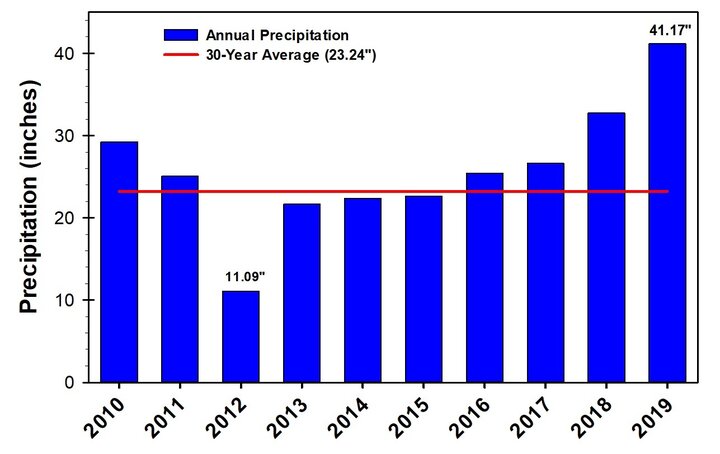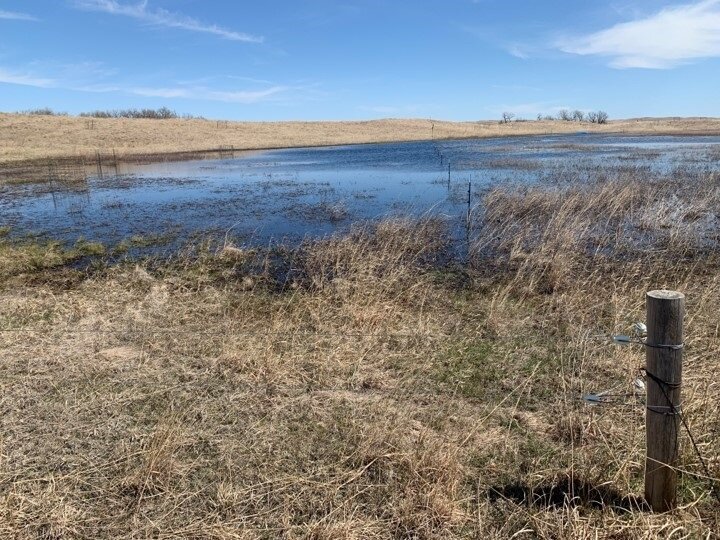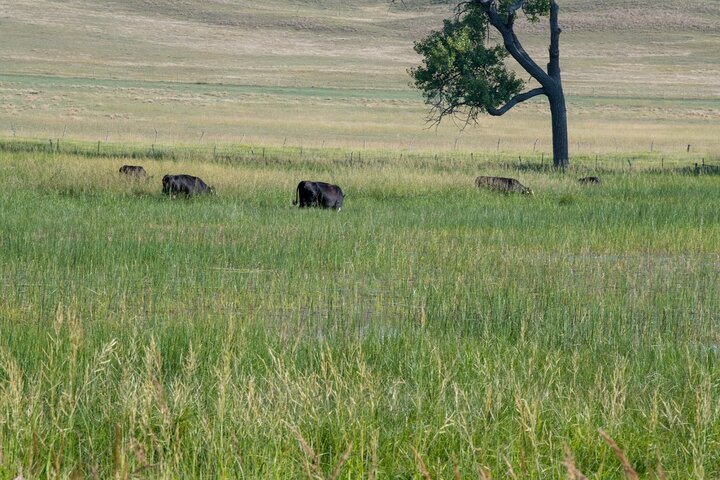Meadows cover approximately 10% of the land area in the Nebraska Sandhills. These meadows have both subirrigated and wetland ecological sites that are an important forage resource (hay and grazing) for many ranches in the Sandhills. Meadows typically provide 2 to 3 times more forage than associated Sandhills uplands. Meadows are also vital to the biodiversity and hydrology of the Sandhills with many native wildlife and plant species found in these subirrigated and wetland areas.
Above average annual precipitation during several of the past years has caused a number of meadows and upland interdunal sites to be flooded. A location in Rock County, for example, reported over 41 inches during 2019 and nearly 33 inches in 2018, which is well above the long-term average of 23 inches (See Figure 1). Many of these areas remain under water and it is likely they will continue to be flooded into the 2020 growing season. This excess water may take time to disappear as absorption into the groundwater aquifers can be a slow process. Evaporation and surface drainage will play a role as well in reducing excessive flooding. Many meadow plant species can withstand some seasonal water inundation, but the extent and duration of this event will likely cause some plant mortality in areas that have had standing water since last summer.

There are passive and active options to consider when managing these areas for recovery. For many flooded areas on subirrigated meadows, the best option is to let nature take its course. Many plant species on these areas are resilient to flooding and should recover after the flood waters recede. Depending on how quickly the water recedes, wetland species such as cattails and rushes may appear in some areas and thrive as long as there is some standing water. On subirrigated sites where the water completely disappears, less desirable species will likely come into these areas. This includes a variety of annual broadleaf weeds like lambsquarters, several mustard species, or smartweeds. Eventually, sedge species and grasses will revegetate the areas. In some cases, introduced cool-season species such as Kentucky bluegrass, quackgrass, or other introduced cool-season grasses may be the dominant species in areas where these species were present before flooding. It is expected that over time more desirable species will come back into these areas, but it may take years to fully recover plant communities in terms of plant species composition and productivity. Furthermore, the plant communities that develop on the site may continue to evolve and never return to their composition prior to flooding. Plant community dynamics on individual sites will likely vary depending on the ongoing degree of wetness, propagules available from surrounding vegetation, and haying and grazing practices that take place post-flooding.
Adaptively managing meadows by altering the timing of defoliation, such as haying and grazing in altering years at different times during the year, may provide opportunities for management on meadows as they recover from flooding events. Flooded areas have likely flooded in the past and will continue to flood during wet periods in the future, so planning for this event is just as important as drought management planning when forage production on uplands is limited by lack of precipitation. Having alternative feed resources and management plans in place will help guide the recovery of these formerly flooded areas.
Planting native or introduced species are options in areas accessible to planting equipment. Native grasses and sedges should be considered before introduced species to maintain the function and use of these meadow resources as natural environments. Seeding introduced cool-season perennial grasses can increase forage quantity and quality relative to some native species but before you start up the tractor it is important to consider the ecological costs of planting introduced species into these meadow environments. Some introduced species can spread aggressively into other areas of the meadows, creating near monoculture conditions. Reed canarygrass, for example, can have negative implications for subirrigated meadow ecological sites causing reduced hydrological flow of water, decreased value for wildlife habitat, and increased challenges for management (e.g., aggressively spreading species may require intensive management with fire or targeted grazing to keep from further spreading). Producers should consider what species are present in their meadows (See Table 1 for a list of common native and introduced species on Sandhills meadows) and select species that will best support multiple objectives (e.g., forage production, wildlife habitat, etc.).

In addition to persistent high water on subirrigated meadows, there are lower-lying upland, sandy ecological sites or interdune swales, that currently have standing water (See Figure 2). Plant species in these areas are not accustomed to flooding events and there may be especially high mortality on plants in these areas. Allowing these areas opportunities to recover naturally is also beneficial. However, if reseeding is planned on these sites, the species should be native species similar to those found on adjacent unflooded areas. Close monitoring through periodic visits and photo points will help track the recovery process and aid in determining if additional management is warranted to decrease the time of recovery.

If reseeding is planned, check with your local Natural Resource District (NRD) or a local Pheasants Forever chapter for options to rent range drills if you do not have this equipment available. Local NRCS offices can provide recommendations for native seed mixtures and guidance on best management practices. Lastly, local seed companies will also have recommendation for seed mixes available in your area.
Reclaiming Flood-damaged Pastures and Forage Production
https://beef.unl.edu/beefwatch/reclaiming-flood-damaged-pastures-and-forage-production
Grazing Cattle on Subirrigated Meadows
https://journals.uair.arizona.edu/index.php/jrm/article/viewFile/5404/5014
Interviews with the authors of BeefWatch newsletter articles become available throughout the month of publication and are accessible at https://go.unl.edu/podcast.
Topics covered:
Grazing systems & best practices, Pasture & range, Pasture & range

